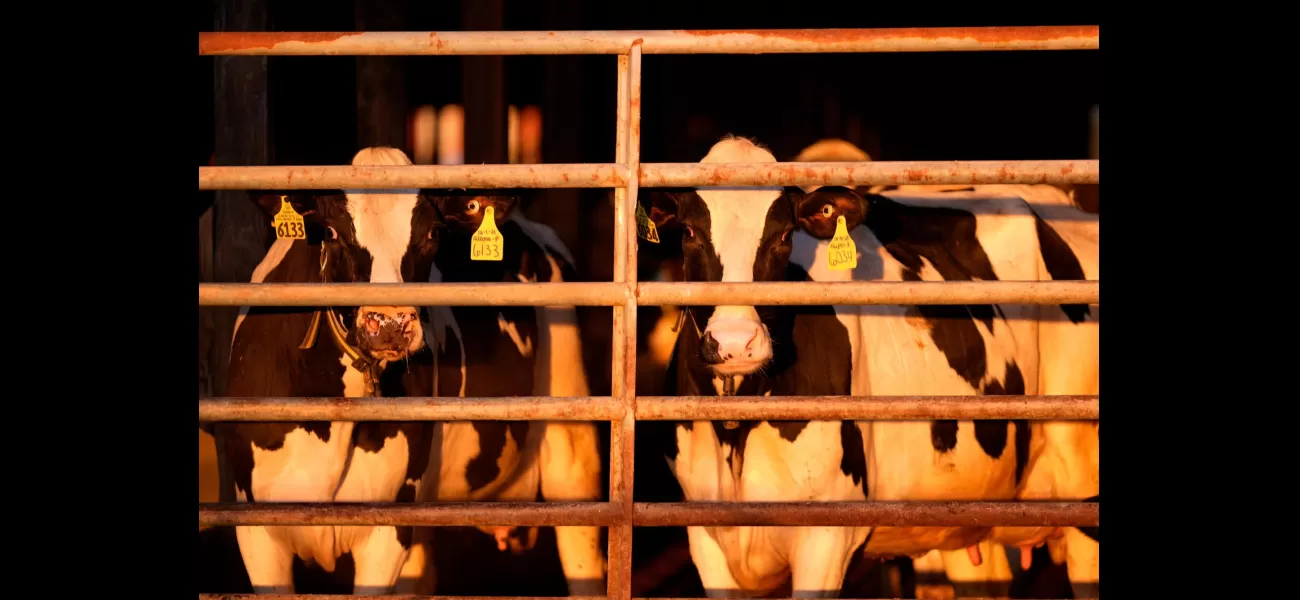US promises financial and other support to monitor and control bird flu outbreaks on dairy farms.
The funds will be used to prevent, test, track and treat animals and humans potentially affected by the virus known as Type A H5N1, with a total of $101 million allocated for this purpose.
May 11th 2024.

On Friday, U.S. health and agriculture officials announced a new plan to contain an outbreak of bird flu in dairy cows across nine states. They have set aside a budget of nearly $200 million to fund various efforts, including preventing, testing, and treating both animals and humans affected by the virus.
According to the U.S. Department of Health and Human Services, $101 million will be used to continue ongoing efforts in dealing with the virus, while another $98 million will be allocated to individual farms for testing and improving biosecurity measures. Additionally, dairy farmers will be compensated for the loss of milk production caused by infected cattle, and both farmers and farm workers will be paid to participate in a workplace study conducted by the USDA and the Centers for Disease Control and Prevention.
The National Milk Producers Federation, a trade group representing dairy farmers, expressed their support for these initiatives, emphasizing the importance of caring for farm workers and animals, as well as addressing potential health risks and reassuring the public.
One of the major challenges in containing the virus has been farmers' reluctance to allow health officials onto their farms for testing, due to concerns about the impact on their businesses. Similarly, farm workers, especially migrant workers, have been hesitant to get tested out of fear of missing work or being monitored by the government.
Keith Poulsen, director of the Wisconsin Veterinary Diagnostic Laboratory, believes that these new incentives will encourage farmers to be more cooperative in testing their herds. He also stated that the additional funding will help steer efforts in the right direction.
The announcement of this new spending comes six weeks after the first detection of avian bird flu in dairy cattle, with one confirmed case in a Texas dairy worker who recovered from a mild eye infection. As of now, there have been 42 confirmed infections in dairy cows across nine states, and the Agriculture Secretary Tom Vilsack noted that the outbreak has not spread more widely.
However, there have been concerns that the outbreak could be more widespread, as the U.S. Food and Drug Administration found remnants of the virus in 1 in 5 samples of retail milk nationwide. As a precaution, farmers are now required to test lactating dairy cattle for H5N1 before moving them between states.
The FDA confirmed that pasteurization is effective in killing the virus, but warned against consuming unpasteurized milk. They are currently conducting tests on raw milk samples to determine the level of the virus that pasteurization needs to eliminate. The USDA also found no evidence of the virus in a sample of retail ground beef.
Despite these developments, Health and Human Services Secretary Xavier Becerra assured the public that the risk of the outbreak is still low.
According to the U.S. Department of Health and Human Services, $101 million will be used to continue ongoing efforts in dealing with the virus, while another $98 million will be allocated to individual farms for testing and improving biosecurity measures. Additionally, dairy farmers will be compensated for the loss of milk production caused by infected cattle, and both farmers and farm workers will be paid to participate in a workplace study conducted by the USDA and the Centers for Disease Control and Prevention.
The National Milk Producers Federation, a trade group representing dairy farmers, expressed their support for these initiatives, emphasizing the importance of caring for farm workers and animals, as well as addressing potential health risks and reassuring the public.
One of the major challenges in containing the virus has been farmers' reluctance to allow health officials onto their farms for testing, due to concerns about the impact on their businesses. Similarly, farm workers, especially migrant workers, have been hesitant to get tested out of fear of missing work or being monitored by the government.
Keith Poulsen, director of the Wisconsin Veterinary Diagnostic Laboratory, believes that these new incentives will encourage farmers to be more cooperative in testing their herds. He also stated that the additional funding will help steer efforts in the right direction.
The announcement of this new spending comes six weeks after the first detection of avian bird flu in dairy cattle, with one confirmed case in a Texas dairy worker who recovered from a mild eye infection. As of now, there have been 42 confirmed infections in dairy cows across nine states, and the Agriculture Secretary Tom Vilsack noted that the outbreak has not spread more widely.
However, there have been concerns that the outbreak could be more widespread, as the U.S. Food and Drug Administration found remnants of the virus in 1 in 5 samples of retail milk nationwide. As a precaution, farmers are now required to test lactating dairy cattle for H5N1 before moving them between states.
The FDA confirmed that pasteurization is effective in killing the virus, but warned against consuming unpasteurized milk. They are currently conducting tests on raw milk samples to determine the level of the virus that pasteurization needs to eliminate. The USDA also found no evidence of the virus in a sample of retail ground beef.
Despite these developments, Health and Human Services Secretary Xavier Becerra assured the public that the risk of the outbreak is still low.
[This article has been trending online recently and has been generated with AI. Your feed is customized.]
[Generative AI is experimental.]
0
0
Submit Comment





